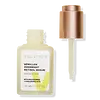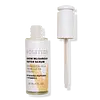What's inside
What's inside
 Key Ingredients
Key Ingredients

 Benefits
Benefits

 Concerns
Concerns

No concerns
 Ingredients Side-by-side
Ingredients Side-by-side

Water
Skin ConditioningPropanediol
SolventPropanediol Dicaprylate
EmollientSodium Hyaluronate
HumectantSucrose Palmitate
EmollientGlyceryl Linoleate
EmollientHydroxyethyl Acrylate/Sodium Acryloyldimethyl Taurate Copolymer
Emulsion StabilisingRetinol
Skin ConditioningVitis Vinifera Seed Extract
AntimicrobialNiacinamide
SmoothingVaccinium Macrocarpon Fruit Extract
AstringentGlycerin
HumectantGlycine Soja Extract
Skin ConditioningTocopheryl Acetate
AntioxidantCyclodextrin
AbsorbentPotassium Sorbate
PreservativeCitric Acid
BufferingPhenoxyethanol
PreservativeEthylhexylglycerin
Skin ConditioningWater, Propanediol, Propanediol Dicaprylate, Sodium Hyaluronate, Sucrose Palmitate, Glyceryl Linoleate, Hydroxyethyl Acrylate/Sodium Acryloyldimethyl Taurate Copolymer, Retinol, Vitis Vinifera Seed Extract, Niacinamide, Vaccinium Macrocarpon Fruit Extract, Glycerin, Glycine Soja Extract, Tocopheryl Acetate, Cyclodextrin, Potassium Sorbate, Citric Acid, Phenoxyethanol, Ethylhexylglycerin
Water
Skin ConditioningGlycerin
HumectantPropanediol
SolventArgania Spinosa Kernel Oil
EmollientTremella Fuciformis Extract
HumectantSodium Hyaluronate
HumectantSea Water
HumectantCitrullus Lanatus Fruit Extract
Skin ConditioningPyrus Malus Fruit Extract
Skin ConditioningLens Esculenta Fruit Extract
Skin Conditioning3-O-Ethyl Ascorbic Acid
Skin ConditioningN-Prolyl Palmitoyl Tripeptide-56 Acetate
Skin ConditioningDiheptyl Succinate
EmollientCaprylyl Glycol
EmollientHydroxypropyl Methylcellulose
Emulsion StabilisingPolyglyceryl-4 Caprate
EmulsifyingXanthan Gum
EmulsifyingCapryloyl Glycerin/Sebacic Acid Copolymer
Skin ConditioningSodium PCA
HumectantSodium Lactate
BufferingPentylene Glycol
Skin ConditioningSodium Carbomer
Emulsion StabilisingEthylhexylglycerin
Skin ConditioningPhenoxyethanol
PreservativeWater, Glycerin, Propanediol, Argania Spinosa Kernel Oil, Tremella Fuciformis Extract, Sodium Hyaluronate, Sea Water, Citrullus Lanatus Fruit Extract, Pyrus Malus Fruit Extract, Lens Esculenta Fruit Extract, 3-O-Ethyl Ascorbic Acid, N-Prolyl Palmitoyl Tripeptide-56 Acetate, Diheptyl Succinate, Caprylyl Glycol, Hydroxypropyl Methylcellulose, Polyglyceryl-4 Caprate, Xanthan Gum, Capryloyl Glycerin/Sebacic Acid Copolymer, Sodium PCA, Sodium Lactate, Pentylene Glycol, Sodium Carbomer, Ethylhexylglycerin, Phenoxyethanol
 Reviews
Reviews

Ingredients Explained
These ingredients are found in both products.
Ingredients higher up in an ingredient list are typically present in a larger amount.
Ethylhexylglycerin (we can't pronounce this either) is commonly used as a preservative and skin softener. It is derived from glyceryl.
You might see Ethylhexylglycerin often paired with other preservatives such as phenoxyethanol. Ethylhexylglycerin has been found to increase the effectiveness of these other preservatives.
Glycerin is already naturally found in your skin. It helps moisturize and protect your skin.
A study from 2016 found glycerin to be more effective as a humectant than AHAs and hyaluronic acid.
As a humectant, it helps the skin stay hydrated by pulling moisture to your skin. The low molecular weight of glycerin allows it to pull moisture into the deeper layers of your skin.
Hydrated skin improves your skin barrier; Your skin barrier helps protect against irritants and bacteria.
Glycerin has also been found to have antimicrobial and antiviral properties. Due to these properties, glycerin is often used in wound and burn treatments.
In cosmetics, glycerin is usually derived from plants such as soybean or palm. However, it can also be sourced from animals, such as tallow or animal fat.
This ingredient is organic, colorless, odorless, and non-toxic.
Glycerin is the name for this ingredient in American English. British English uses Glycerol/Glycerine.
Learn more about GlycerinPhenoxyethanol is a preservative that has germicide, antimicrobial, and aromatic properties. Studies show that phenoxyethanol can prevent microbial growth. By itself, it has a scent that is similar to that of a rose.
It's often used in formulations along with Caprylyl Glycol to preserve the shelf life of products.
Propanediol is an all-star ingredient. It softens, hydrates, and smooths the skin.
It’s often used to:
Propanediol is not likely to cause sensitivity and considered safe to use. It is derived from corn or petroleum with a clear color and no scent.
Learn more about PropanediolSodium Hyaluronate is hyaluronic acid's salt form. It is commonly derived from the sodium salt of hyaluronic acid.
Like hyaluronic acid, it is great at holding water and acts as a humectant. This makes it a great skin hydrating ingredient.
Sodium Hyaluronate is naturally occurring in our bodies and is mostly found in eye fluid and joints.
These are some other common types of Hyaluronic Acid:
Learn more about Sodium HyaluronateWater. It's the most common cosmetic ingredient of all. You'll usually see it at the top of ingredient lists, meaning that it makes up the largest part of the product.
So why is it so popular? Water most often acts as a solvent - this means that it helps dissolve other ingredients into the formulation.
You'll also recognize water as that liquid we all need to stay alive. If you see this, drink a glass of water. Stay hydrated!
Learn more about Water